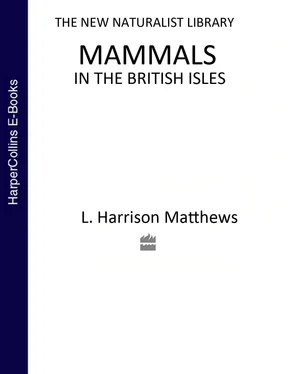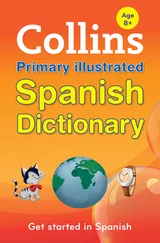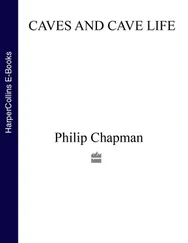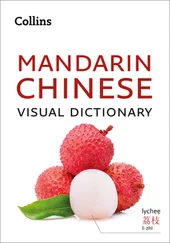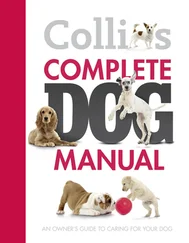We shall now briefly pass in review the different kinds of mammal, and their taxonomic classification, before going on to consider their habits, habitats and ways of life. We fortunately do not need to enter into minute description of their diagnostic characters and structure, or the basic details of their biology, which are all set forth with great clarity in the second edition of the Handbook of British Mammals, edited for the Mammal Society by G.B. Corbet and H.N. Southern, and published in 1977, a work indispensible to naturalists interested in British Mammals. 39
Many naturalists have worked out schemes of classification for animals both before and since the Swedish naturalist Carl von Linné, whose name is latinised as Linnaeus, invented the binomial system. He gave each kind of animal and plant a specific name, and grouped the species, ‘species’ being merely the latin for ‘kind’, that showed some resemblance to each other into genera, singular ‘genus’, the latin for a clan or tribe. For example he classified the rats and mice into the genus Mus, giving the specific names Mus rattus to the black rat, Mus musculus to the house mouse, and Mus sylvaticus to the wood mouse. Since his time they have been separated into different genera, but still retain their specific names.
Before the time of Linnaeus naturalists distinguished species by using cumbrous compound names often amounting to short descriptive sentences. For example, Linnaeus named the daisy of our lawns and fields Bellis perennis , whereas many earlier botanists called it ‘ Bellis scapo nudo unifloro ’. Early writers in English often used expressions that appear quaint to modern eyes; Edward Topsell whose ‘Historie of Foure-footed Beastes’ was published in 1607–08, heads his chapter on mice ‘Of the vulgar little Mouse’ – meaning the ‘common house mouse’ – to distinguish it from the ‘Vulgar Rat, or great domesticall Mouse’.
When species are classified into genera, the genera themselves need to be arranged into convenient groups, the genera in each having some characters in common. Thus genera are gathered into families, families into orders, orders into classes, and classes into phyla (singular, phylum). Intermediate grades such as superfamily or subfamily are often used for finer divisions of classification. Thus the mammals are put into the Class Mammalia of the sub-phylum Vertebrata of the Phylum Chordata; and the ‘vulgar little mouse’ becomes Mus musculus of the genus Mus , of the Family Muridae, of the Order Rodentia, of the class Mammalia.
Although this system of classification is linear it must not be read as though it were a genealogy or family tree in which the successive levels are the descendants of the previous ones. It is merely a convention and a convenience, at least partly determined by the necessity of representing it in only two dimensions on a written or printed sheet of paper. In nature all the living species of animal are on a single level, and can be likened to the tips of the twigs of a three-dimensional tree, of which the dead-wood in the branches, limbs and trunk represents the extinct ancestors of the living species. The analogy is the more apt because the wood ascends continuously from its origin to its utmost ramifications unlike a family tree which is inverted and where the descent is cut up into generations.
The scheme of classification for the mammals now almost universally accepted and adopted by naturalists was worked out by the American zoologist G.G. Simpson and published in 1945. 131Some minor modifications have been made to it during the last thirty-five years, but it has proved so useful, and is supported by such erudite and convincing arguments, that it has become the standard system adopted by zoologists throughout the world. According to the modified Simpson’s system there are 33 orders of mammals, 14 of which are extinct; 257 families, of which 139 or 54 per cent are extinct; and 2,864 genera, of which 1,932 or 67 per cent are extinct. Thus the living species represent only a small fraction of the total that have lived since the class Mammalia evolved. The diversity and number of species in all the orders except perhaps the rodents reached their peak in the Miocene or Pliocene epochs – some twenty-five to three million years ago – since when they have declined to their present level.
In the British Isles, excluding the whales, we have mammals representing nine of the nineteen orders now living, but of these only seven are indigenous, the two others are either introduced and naturalised, or are derived from stocks of domestic animals. Our fauna is therefore no more than a small sample of the mammalian diversity that ornaments the fauna of the world. It has, moreover, not contained a larger number of orders since the land became generally habitable by warm-blooded animals at the end of the great glaciation of the Pleistocene epoch, about half a million years ago. In the preceeding epochs, before the ice ages, several other orders were represented by species of mammal that became extinct long before the present pattern of the fauna evolved.
Before we discuss the problematic origin of the present fauna we should enumerate and specify the species about which we shall be speaking. In following Simpson’s arrangement of the orders the indigenous species are necessarily not separated from those that have been introduced or are extinct.
ORDER MARSUPIALIA
The marsupials differ so fundamentally from the other mammals that they are placed in a separate Infraclass, the Metatheria, whereas the other mammals of our fauna are included in the Infraclass Eutheria. The marsupials show many unique anatomical characters, but are popularly known merely by a single one, as the mammals that carry their young in a pouch. This is not universally true, for some of them are pouchless; but in all of them the young are born at a comparatively early stage of development and thus need to be carried attached to the mother’s nipples. The marsupials are typically the mammals of the Australasian region, but in addition many species live in South America and one, the Virginian opossum, extends into North America. The living species are divided into eight families of which one, containing the kangaroos and wallabies, is represented in our fauna by a single introduced species.
Family Macropodidae
Macropus rufogriseus , the red-necked wallaby or Bennett’s wallaby, is a medium sized kangaroo-like animal weighing up to about 30 pounds, sometimes nearly 50 pounds. It is native to south-eastern Australia and Tasmania; but as it is easily kept in captivity it is commonly exhibited in zoos and parks of many lands, whence it sometimes escapes. Small feral populations of that origin have become established in Sussex and Derbyshire; smaller colonies deliberately introduced on Herm in the Channel Islands, and on Lambay Island off the coast of Co. Dublin in Eire have died out. Although the English populations have been established for over thirty years they remain small because wallabies are liable to suffer heavy mortality in severe winters.
ORDER INSECTIVORA
The insectivores are mostly small mammals characterised by many primitive or generalised mammalian characters. They are considered to be descended with least change from the ancestral stock of the mammals, though all living species have various specialised adaptations. Insectivores live in most parts of the world except Australasia and South America; they include the tenrecs, hedgehogs, moles, desmans, and shrews.
Family Erinaceidae
Erinaceus europaeus , the hedgehog, our only mammal with prickles in its skin, is the largest of our insectivores. It is present throughout the mainland of Great Britain and Ireland and is common in lowland areas, particularly in the suburbs of towns. It is also found in many of the islands, but has probably been introduced into most of them by man. It lives in woods and hedgerows, coming into the open to feed as night falls. The hedgehog and the dormouse are our only mammals besides the bats that hibernate in winter.
Читать дальше
